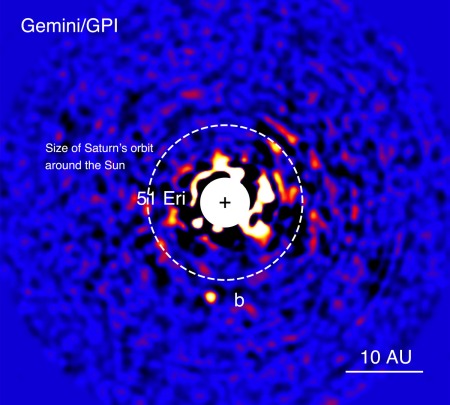Direct imaging discovery of a companion to 51 Eridani
Astronomers have found the smallest planet outside this solar system yet to be directly photographed by a telescope on Earth, a methane-shrouded gas giant much like a young Jupiter. The exoplanet 51 Eridani b orbits the ~20 Myr old F0 star 29.4±0.3 parsecs from Earth in a planetary system that may be much like Earth’s own solar system. The discovery could shed light on how our solar system formed, scientists added. Over the last 20 years, astronomers have confirmed the existence of more than 1,800 exoplanets, or alien planets around other stars. Many of these worlds are quite unlike any planets in Earth’s solar system. For example, so-called “hot Jupiters” are gas giants that orbit their host stars more closely than Mercury does the sun. More than 1,000 of the exoplanets confirmed to date were discovered by NASA’s Kepler Space Telescope. Kepler indirectly finds planets by detecting a loss of starlight as a world passes in front of its star. However, this new planet was discovered using the Gemini Planet Imager, an instrument on the Gemini South telescope in Chile, which directly detects exoplanets by looking for light from the worlds themselves. “To detect planets, Kepler sees their shadow,” study lead author Bruce Macintosh, lead investigator on the Gemini Planet Imager and an astrophysicist at Stanford University in California, said in a statement. “The Gemini Planet Imager instead sees their glow, which we refer to as direct imaging.” The scientists detailed their findings online Aug. 13 in the journal Science. [via space.com] [Update: A step toward rewriting planet formation models]

November 2, 2015 at 2:34 pm
[…] a mass estimate of 8.3±0.5 MJup for a 23±3 Myr age. PSO J318.5-22 is intermediate in mass between 51 Eri b and β Pic b, the two known exoplanet companions in the β Pic moving group. With variability […]
January 29, 2018 at 6:28 pm
Reblogged this on Rosettasister's Weblog.